Fit Lesson 6: Suits & Sport coats.
Posted on August 17, 2009 in Basic Fit Lessons, Body Type, Dress, Fit Lesson, Popular, Sport Coats, Suits, Tailoring.Now that we’ve got most of the basics covered, it’s time to tackle The Suit. This is an incredibly important article of clothing: when you’re suited up you implicitly are putting yourself on a stage, whether it’s for work or play. A suit amplifies (and signifies) everything: style, taste, body shape, personality. So, the worst thing you can do is put on an ill-fitting, or out of style suit.
The common mistake is assuming that a suit will fit you right off the rack. This couldn’t be further from the truth (even if you’re buying a $2-3k suit). PG has been lobbying for getting to know your tailor for just about every article of clothing, and based on feedback I can tell that you’re listening. Well, the suit is the granddaddy of them all and should fit perfectly. I can’t stress this enough: it is very unlikely that some amount of tailoring will not be required when purchasing a non-custom made suit.
If you’re in an office that requires a suit, don’t dumb it down and go for the status quo. The baggy coat and pleated pants look doesn’t look good on anybody. If you’re young and stylish, you owe it to yourself to dress more attractively. The cumulative total of even subtle changes will make a huge difference.
There are a myriad of variables that go into a suit, from fit to fabric, but for now we’ll focus on the fit rules and save whatever wildcards there may be for subsequent posts. In general, you want it form-fitting and comfortable. Something that doesn’t just drape on you, or give a boxy silhouette.
This is a long post, but it’s very important. So stay with me.
*Note: most of the suits highlighted in this post tend towards the more inexpensive side. This is intentional. Typically, with suits if you’re spending a lot of $$, and go with a modern designer, it should be easy to find a well-fitting suit. You just have to be more vigilant at more frugal price points.
Pants
When wearing a suit, it’s even more paramount to ensure that your pants fit you well, so make sure you’re following the rules on how pants should fit. The highlights: flat front, precise leg width, sits just below the waist, and has one break in the pant leg (the top of your pants should rest naturally over your shoe, and just above the heel of your shoe in the back). This will give a clean silhouette, without all the excess baggy fabric you see frequently.
If you’ve got a significantly larger chest than your waist, or vice versa, go for stores that sell suit separates to ensure you’re getting the proper fit for both your coat and your pants. Among the mass market brands: Brooks Brothers, JCrew, Express, Banana all sell separates.
Oh, and no pleats.
Coat
Generally, suit and sport coats should mirror the same sort of advice given for shirts. The general idea is buying a coat with a lot less fabric then you’re used to, giving you a coat that fits your body precisely, no matter the type.
But, it does get a little bit more complicated. Here are the important sub-categories.
Shoulders
Once you’ve got the proper chest measurements, ensure that your shoulder placement is correct. You want the shoulder seam to extend to the point where your shoulders end (where your deltoids begin the slope down), no further or less.
Try to avoid heavily padded shoulders or else you’ll look like Goofy trying to play football. This typically won’t be a problem if you go with a modern label, as this sort of thing has fallen out of favor in the past decade or so. The effect of padded shoulders creates a boxy silhouette, something that we’re trying to avoid.
If you’ve got slim/narrow shoulders, don’t get fooled into thinking that shoulder pads will help. This look is incredibly unnatural, and will make you look more out of place. Instead, opt for a well-tailored suit around the shoulders and a shorter waist (see below).
Torso
Regardless of if you like modern or traditional styles, the torso region should be fitted nicely to the contours of your body. Just like with shirts, the tendency is for guys to buy suit coats that fit properly in the chest, without a thought to their midsection. With suits, this causes a draping effect that looks frumpy. You want the sides of your midsection to be indented slightly with regards to your chest.
As you probably guessed, I think of lines. The key is that the lines from your arm pits to your waist shouldn’t be like parallel lines (| |), there should be some curve like this: ) ( . The suit may not look like this off the rack, but this is a simple fix by any good tailor.
Since bigger guys tend to look unkempt easier than others, this region is especially important. Ensure that your suit coat fits your body precisely (not tightly). You don’t want your coat to add any more girth
Notice how the silhouette for the #1 is boxy and very linear. No good contours. Compare that to the nicely tailored suit in #2.
1.
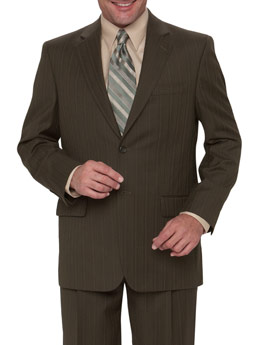
Photo credit: Men's Wearhouse.
2.
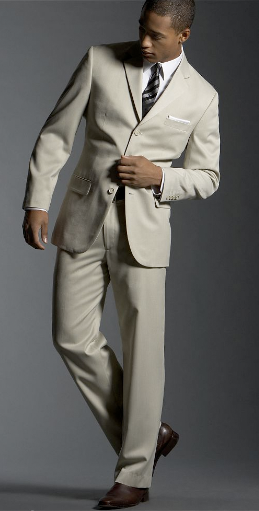
Photo credit: Macys.
Length of the Coat
Stand tall with your hands at your side. Now cup your hands. Within this cup should be where your suit ends. Most likely, this is shorter than you’re accustomed to. This is especially important for the shorter guys, as a longer suit will make you look like you’re a boy in his dad’s suit.
I’m on the shorter side, and opt to have my tailor shorten my coats a bit more than that mentioned above. This is definitely a modern look, and helps to make me look a bit longer.
For big and tall guys, I’d avoid going too short with the coat. The above method for determining the length should be sufficient. Don’t go longer or you’ll look like a sidelined NBA player.
Regardless of your style, it should be fairly easy work for a good tailor to shorten your existing suits.
Take a look at #3, and notice that the coat is way too long for any body type and compare this back to the coat length of #2.
3.
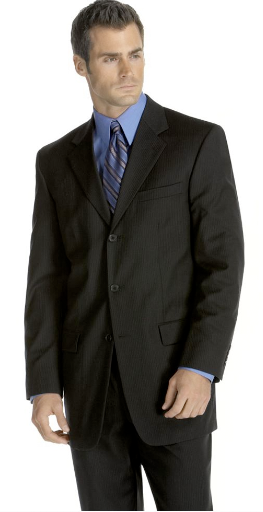
Photo credit: Macys.
Sleeve length
Buy a suit (or get it tailored down) to where a little bit of the cuff of your shirt shows through. Conventional wisdom says between 0.25″ and 0.5″. This gives a nice break between your hand and your suit, thus preventing you from looking like your suit coat is way too long. This is especially important for shorter guys, because you’ll look like a kid in a suit if your coat sleeves extend to your knuckles. For super tall guys, opt for the shorter end of the cuff-exposing spectrum.
This is something I’ve seen E from Entourage do excessively, which really amplifies his slight stature.
4.
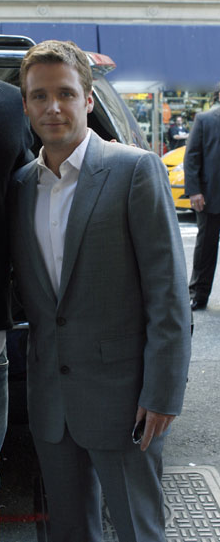
Photo credit: Starpulse.
Buttons
Two button suits are becoming more commonplace as it lends itself a little easier to the shorter coat length, slimmer style that is popular now. However, three button suits aren’t inherently unstylish.
If you’re wearing a two button suit, don’t button the bottom button. Buttoning a single button allows the coat to fall more naturally.
For a three button suit it depends on the placement of the buttons. If the suit opening is cut a bit lower, then button only the middle button. If it’s cut higher, then button the top button (in this instance the middle button is optional).
Again, don’t ever button the bottom button.
One button suits are traditionally used only for formal occasions.
Lapels
Thinner width lapels are typically more on-trend and modern. Other than that, it’s a good idea to know the three main styles of lapels:
Notch: the most common. A small notch cut out. Pretty much acceptable for all occasions.
Peak: large pronounced V-shape. These may be what you’d think of on a tuxedo, but aren’t necessarily restricted to formal occasions. Just don’t go overboard with the width or you’ll look like an extra from Saturday Night Fever.
Shawl collar: this is rounded, almost like a smoking jacket. Typically these lapels are on coats for formal occasions.
___
And now for good examples.
A nice traditionally-inspired suit, well-tailored but nothing dramatic. It just looks clean (notice the thin lapels).
5.
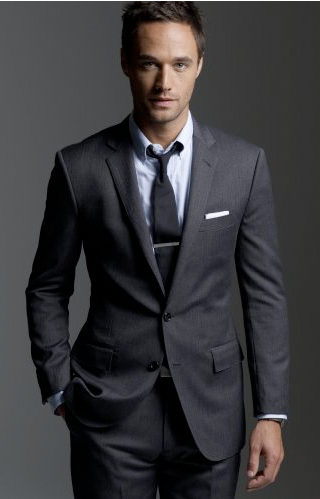
Photo credit: JCrew.
I’ve always liked how Ryan Reynolds dresses. The sleeves are a bit long, but the rest of it is spot on. He’s a taller guy but the short, modern coat still looks great on him.
6.
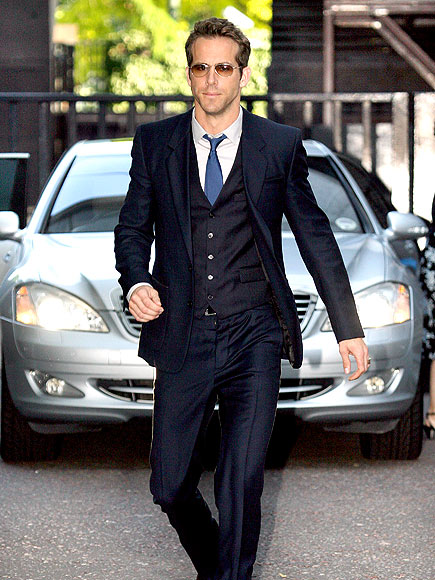
Photo credit: People.
And now a simply perfect suit. Perfect everything.
7.
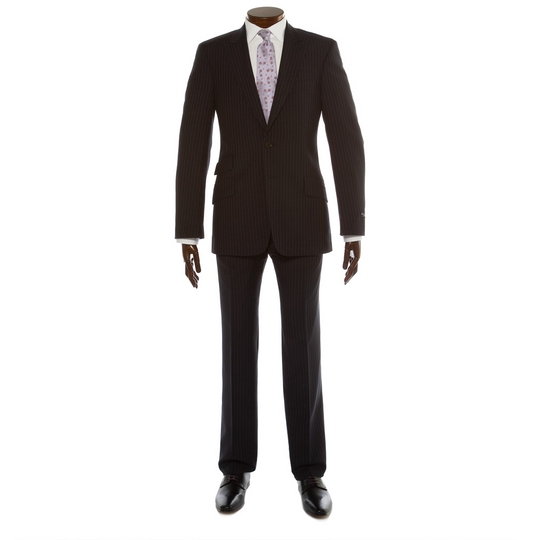
Photo credit: Paul Smith.
___
And finally, please don’t forget the shoes. Get a pair that compliments your newly updated style that follows the rules.
about neck size: i have a friend with a thicker (think nfl linebacker) neck. for that reason, he says he can’t wear a skinny tie because it would exaggerate his neck. is there a range of ties that are “slimmer” but not “skinny”? additionally, i suggested a slimmer lapel on his suit to visually thin the neck. or is it best to go with a fuller lapel that would be more proportionate?
Good question. I’ve planned on doing a Fit Lesson on Ties as it pertains to body type in a subsequent post, but I’ll hit the highlights now.
Ties have been moving towards the skinny spectrum for a few years now, and it looks great on the right body type. However, the skinny tie (usually around 2.5″ or less at the widest point) are best suited for trimmer guys.
For the larger, you can still go more modern. A normal, traditional neck tie is between 3.5″ – 3.75″ at it’s widest point. There are plenty of designers who are beginning to sell 3″ ties. They’re slimmer, but not slim. He should give those a go.
Conventional wisdom states that the lapel should match the body type. So bigger dude, larger lapel. I wouldn’t go wide though. Just something more substantial. I think the tendency with a skinny lapel is to over exaggerate his girth.
However, If he’s athletically large (with the V-shape), I think he may be able to get away with a skinnier lapel.